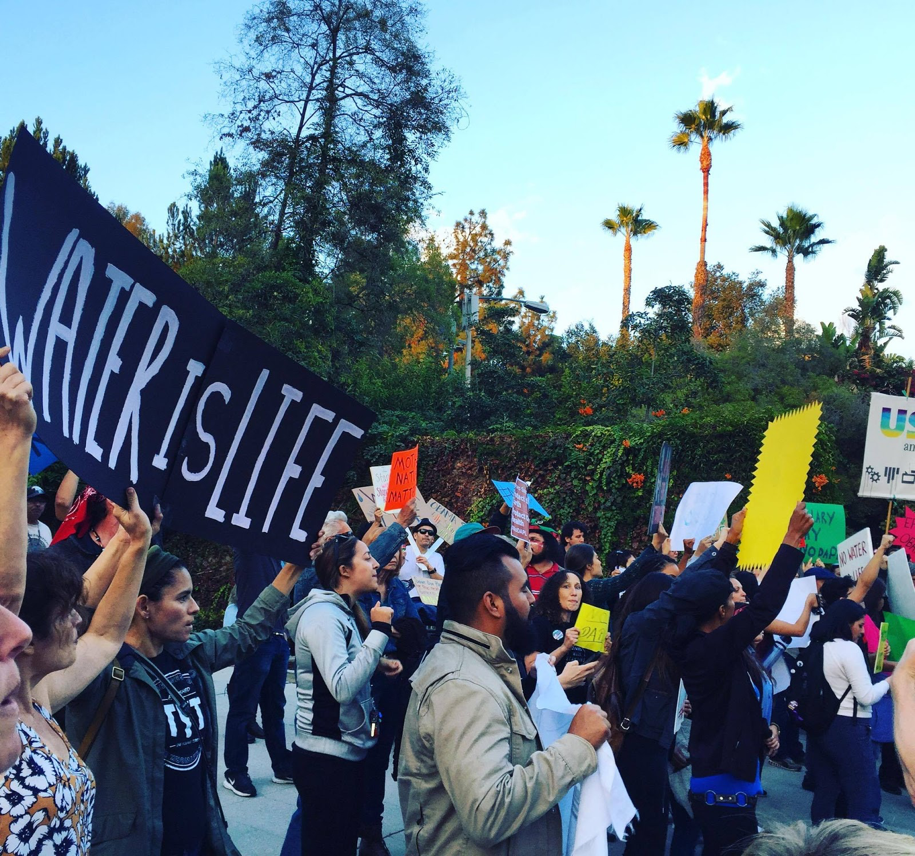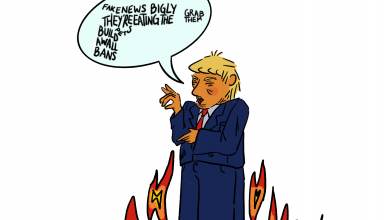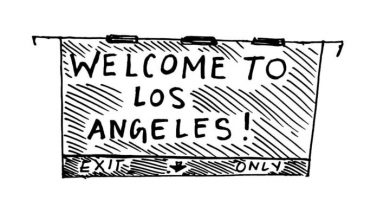Human Unity: The Sights and Sounds from a DAPL Protest

Image courtesy of Eugene Lee
“Water is life!”
This was one of the frustrated chants that a group of protesters gathered outside Greystone Park in Beverly Hills shouted on the evening of October 24th. They held colorful signs above their heads expressing their dissent and stood face-to-face with the Beverly Hills Police Force, unafraid and determined to draw the attention of President Barack Obama. In Los Angeles to raise money for the Democratic presidential nominee, Hillary Clinton, his route to the fundraiser would include driving past Greystone Park.
The protesters came together in a continued effort to halt the creation of the Dakota Access Pipeline, a $3.8 billion pipeline that would carry 470,000 barrels of crude oil each day to markets and refineries in the Midwest, East Coast, and Gulf Coast regions. The pipeline would run through four states and Sioux Lands, putting the water supply and the surrounding environment at great risk.
The heart of this conflict, however, lies in the violation of the sanctity of Sioux lands. Burial sites, prayer sites, and cultural artifacts are in jeopardy of being lost forever should the construction proceed. The construction of the pipeline would be a continuation of the United States’ historic avaricious behavior toward American Indians.
I stood among the protesters. The scent of burning sage filled my nose, and the sight of colorful signs and flashing police car sirens danced across my vision. I could hear frustration and passion in the voices of the protesters gathered in front of Greystone Park as they decried the injustices taking place. A ceremonial American Indian drum pounded constantly in the background, sounding almost like a heartbeat for the unified group of individuals.
“We can’t drink oil! Keep it in the soil!”
“Mni Wiconi! Water is life!”
When President Obama’s motorcade finally drove by Greystone Park, the protesters’ chants grew louder. The police drew closer to the individuals, calmly instructing them to keep their distance. One officer drew me an imaginary line that I was not allowed to cross. The protesters raised their signs higher as each motorcycle, each black SUV, and finally, a sleek black limousine, drove past us. The sight of that limousine immediately electrified the air and doubled the protesters’ fervor. We were only feet away from the leader of the United States, and even if for a few seconds, we held his attention.
Though this encounter should have been the headline of the evening for me, it was only one of the events of the night. The real highlight was after the chanting had died down, after the signs were lowered, and after everyone gathered around in a circle with solemn expressions on their faces.
An American Indian woman took her place in the center of that circle, her black hair neatly braided and her Converse shoes loosely laced together. She began to address everyone present.
She said she was a descendant of the Lakota people, and that her ancestors had been the ones who had fallen during the Wounded Knee Massacre. She thanked us all for our presence and for the concern that we were showing her brothers and sisters states away in North Dakota. She told us about the children of the Standing Rock Sioux tribe there, describing how rashes had started covering their bodies. She described how animals had started to develop cancerous tumors as a result of the chemicals that had already begun to seep into the surrounding environment. She discussed the sadness she felt every time these things crossed her mind.
Then, she started to pray.
She spoke in English, at first, invoking her Creator in the language we all knew and could understand. But then, she started to speak in another language, one that reminded me of the sounds of nature and of something long lost and sacred. It was the language of her people, a language that, she would later say, was slowly fading with time and with the gradual disappearance of her culture.
No one said a word as she prayed. My heart pounded and my breath stilled as I watched her raise her hands above her head and close her eyes. She turned her body to the East, West, North, and South, calling forth The Creator from all directions. She started to sing during the last part of her prayer, using the American Indian drum and playing it with a constant and steady beat.
Though I could not understand a single word that was being said, I could hear the pain and desperation in her voice and how she greatly hoped that the creation of the pipeline would stop. We were all spellbound by her prayer and wanted, so much, for the outcome to turn in the Sioux people’s favor. The goosebumps on my arms did not subside for a while.
I will never forget what she did after she finished her song and prayer for her brothers and sisters in North Dakota. Once again speaking in English, she began to pray for the well-being of other people who were suffering in the world. She prayed for those whose homes were being destroyed in the Amazon, from the indigenous peoples who lived in the forest to the animal species that were under threat. She asked her Creator to grant enlightenment and understanding to those who were willing to destroy things for money. She pleaded for the destruction of the environment to stop.
The American Indian woman herself was hurting because of the injustices currently taking place, but she did not forget that she was not alone in her pain. The Dakota Access Pipeline is on the verge of destroying homes and her people’s sacred ground, but she did not forget those whose lives have already been ruined and promptly forgotten.
She did not forget, and we should not forget either.




